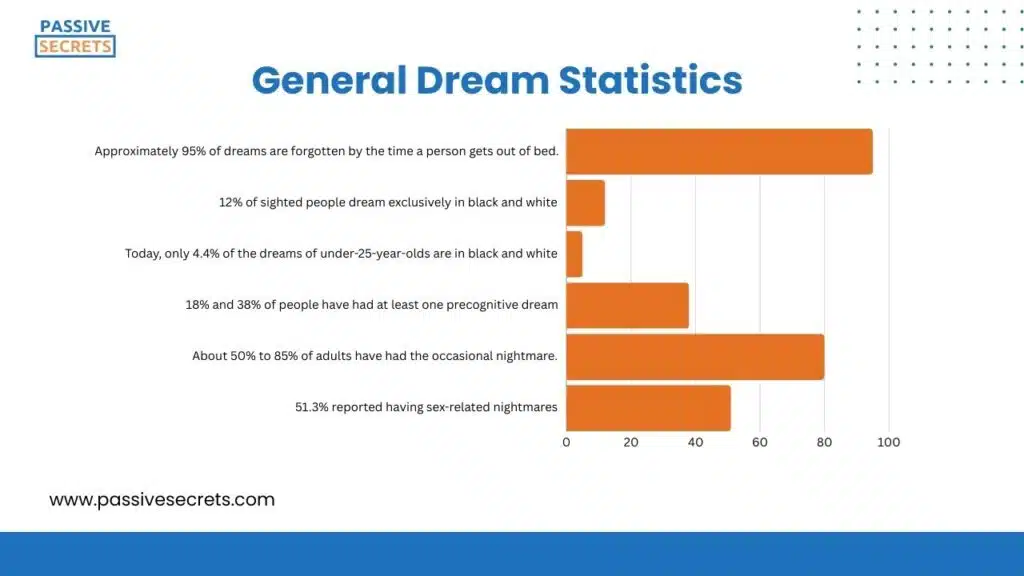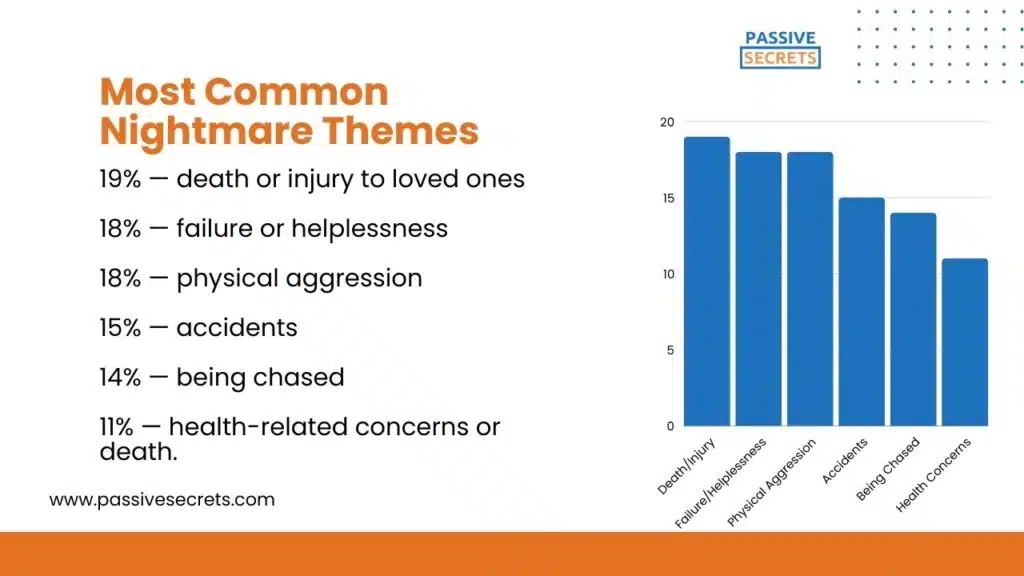
Did you know that, on average, a person spends about six years of their life dreaming?
Dreams are stories and images that our minds create while we sleep.
They are mysterious and captivating, offering a window into our subconscious minds and revealing hidden desires, fears, and emotions.
Research suggests we have 3 to 6 dreams per night, each lasting 5 to 20 minutes.
Discover how fascinating the world of dreams is, from regular dreams to nightmares and even weird dreams. This article presents the most intriguing dream statistics and facts you never knew.
Top Dream Statistics and Facts (Editor’s Pick):
- Approximately 95% of dreams are forgotten when someone gets out of bed.
- 18% and 38% of people have had at least one precognitive dream, with 70% experiencing déjà vu.
- Each dream lasts between 5 and 20 minutes.
- 65% of dreams mirror features of recent waking life events.
- The two most common nightmares were falling and being chased.
- About 50% to 85% of adults have had the occasional nightmare.
- About 2% to 8% of people suffer from nightmares that interfere with their sleep.
- 51.3% reported having sex-related nightmares, with 25.6% having such dreams monthly.
- Men dream about having sex with many partners twice as often as women.
- People who don’t dream lack creativity.
General Dream Statistics
1. Studies of brain activity suggest that most people over the age of 10 years dream between 4 and 6 times each night. (source)
2. Approximately 95% of dreams are forgotten by the time a person gets out of bed. (source)

3. 12% of sighted people dream exclusively in black and white. The remaining percentage of people dream in full colour. (source)
4. Today, only 4.4% of the dreams of under-25-year-olds are in black and white. (source)
5. Several studies show that between 18% and 38% of people have had at least one precognitive dream, with 70% experiencing déjà vu. (source)
6. According to studies, negative emotions like worry and terror are more common in dreams than positive ones. (source)
7. Research shows that only 1-2% of dream reports contain events from wakeful experiences, but 65% of dreams draw from recent waking life experiences. This indicates a strong connection between our waking and dreaming lives. (source)
8. Each dream is believed to last between 5 and 20 minutes. (source)
9. The dream-lag effect has been reported in dreams that occur at the REM stage but not those that occur at stage 2. (source)
10. A study on different types of memory within dream content among 32 people discovered that one dream (0.5%) included an episodic recollection. (source)
11. A study found that 80% of dreams incorporate elements of personal memories, with most featuring low to moderate connections to autobiographical experiences. (source)
12. REM sleep takes up to 20% to 25% of the total sleep time. It is the final phase of sleep (source)
However, the second stage of sleep takes up more, accounting for 45% to 55% of the total sleep time.
13. Several strange characteristics of normal dreams are related to well-known neuropsychological illnesses that develop after brain damage, such as delusional misidentifications of faces and locations. (source)
14. Dreams were studied in persons suffering from various types of headaches. The findings revealed that persons suffering from migraines had more frequent dreams about taste and scent. (source)
15. In a study of 35 professional musicians and 30 non-professionals, musicians reported twice as many music-related dreams than non-musicians. (source)
16. It has been shown that realistic, localized painful sensations can be felt in dreams, either directly or through recollections of pain. (source)
17. Frontotemporal gamma EEG activity has been linked in a study to conscious awareness in dreams. (source)
18. Recent research has found connections between romantic attachment types and dream content. (source)
19. A study of adolescents aged 10 to 17 indicated that those left-handed were more likely to have lucid dreams. (source)
20. In a research of 211 married women, 51.3% reported having sex-related nightmares, with 25.6% having such dreams monthly. (source)
21. Sex dreams are extremely prevalent. According to research, about 70% of people have had at least one of these dreams. (source)
22. Female children more often have anxiety dreams than males. (source)
However, Research shows that girls tend to dream more frequently than boys about themes such as loss, fear, social anxiety, and relationships, with a focus on family, other females, and emotional experiences.
23. Dream reports of those with paraplegia revealed that the participants frequently walked, ran, or swam in their dreams, things they had never done in real life. (source)
24. Compared to 36 able-bodied adults, studies showed that around 80% of the dream reports of participants with deafness presented no evidence of their impairment. (source)
25. A study discovered a relationship between dream recall and brain matter density in the medial prefrontal cortex (MPFC). (source)
26. People under the age of 25 rarely report having black-and-white dreams. However, over 25% of adults over the age of 55 report having both black and white dreams. (source)
27. Several factors influence the emotional content of dreams, including worry, stress, and some drugs. (source)
28. One study discovered that environmental factors, such as good and bad scents, can influence positive and negative dreams. (source)
Nightmare Statistics and Facts
29. Nightmares typically occur during REM sleep, the final stage of the sleep cycle. (source)
30. Trauma-related nightmares, such as those caused by posttraumatic stress disorder (PTSD), can occur in the early phases of sleep as well. (source)
31. An estimated 2% to 8% of people suffer from nightmares that interfere with their sleep. (source)
32. Nightmares are especially common in children aged three to six years. (source)
33. Up to half of young children experience frightening nightmares that lead them to wake up their parents. (source)
34. Children’s nightmares often peak at the age of ten. After that, nightmares generally subside. (source)
35. An estimated 50% to 85% of adults have had the occasional nightmare. (source)
36. Nightmares become less common and intense as you age. (source)
37. Women report nightmares more frequently than men, but they are also more willing to disclose their dreams and nightmares. (source)
38. In most cases, you can recall the nightmare’s contents once you wake up. (source)
39. It is possible to have multiple nightmares in a single night, typically with identical themes. (source)
40. Stress, anxiety, an inconsistent sleep schedule, or being overtired can all raise your risk of having nightmares. (source)
41. Antidepressants, as well as drugs for hypertension or Parkinson’s disease, may increase the frequency of nightmares. (source)
42. Following intense stress or a traumatic experience, it is typical to have the same nightmare repeatedly. (source)
43. Frequent nightmares are more common in children than adults. (source)
44. Research suggests that those experiencing nightmares may have disrupted sleep architecture, resulting in abnormal sleep progression. (source)
45. Some studies suggest a link between nightmares and obstructive sleep apnea (OSA), a breathing ailment that causes interrupted sleep. (source)
46. Nightmare disorder is a parasomnia in which a person experiences recurrent dreams that disrupt their sleep, mood, and/or daytime functioning. (source)
47. Nightmares may also exacerbate mental health disorders that impair sleep, and a lack of sleep can lead to more severe symptoms of conditions such as depression. (source)
48. Treatment for infrequent nightmares is usually not necessary, but for those with nightmare disorder, both psychotherapy and medication can be helpful. (source)
49. A 2018 study published in the Journal of Clinical Sleep Medicine explored the most common nightmare themes in over 1,200 participants. Results as follows: (source)
- 19% — death or injury to loved ones
- 18% — failure or helplessness
- 18% — physical aggression
- 15% — accidents
- 14% — being chased
- 11% — health-related concerns or death.

50. According to Amerisleep’s survey, the two most common nightmares were falling and being chased. (source)
51. Over 50% of the surveyed respondents reported having frequent nightmares about dying, being lost, or feeling trapped. (source)
52. In the survey above, more than 60% of women reported having dreams about a loved one’s death, compared to 39% of males. (source)
53. Women were also more likely than men to experience nightmares about being visited by a deceased family member or acquaintance. (source)
54. Research shows that those with mental health conditions are more likely to have nightmares. (source)
55. According to one study, up to 70% of patients with PTSD, major depressive disorders, and other mental health conditions suffer from recurring nightmares. (source)
56. According to research, some health issues, such as migraines and asthma, can increase the frequency of nightmares. (source)
57. Many people’s nightmares contain work-related anxiety, with concerns about missing deadlines being a frequent theme across various occupations. (source)
58. Men were more likely to have nightmares about technology problems (almost 66%), whereas about 60% of women reported experiencing dreams about bugs crawling on them. (source)
59. Broadcasters and journalists frequently have dreams about missing deadlines. (source)
60. Studies reveal that men are more likely to have nightmares about technology failures (66%). (source)
In comparison, women are more prone to dreams about bugs or creepy crawlies (60%), highlighting gender differences in dream themes.
61. Recurring nightmares are often driven by work-related fears (17%), followed by family and relationship issues (12.5% each), while friendships and health concerns are less common themes (less than 4% each). (source)
62. According to a study’s findings, the left hemisphere appears to offer dream origin, but the right hemisphere provides dream vividness, figurativeness, and emotive activation. (source)
Captivating Facts About Dreams
63. One explanation for why dreams are so difficult to remember: alterations in the brain during sleep do not enable the information processing and storage required to build memories. (source)
64. Dreams can help you learn and form long-term memories. (source)
65. Blind people dream more with different sensory components than sighted persons. (source)
66. In our dreams, we only see faces we already know. (source)
67. Not everybody dreams in colour. (source)
68. Dreams are symbolic. (source)
69. Animals dream too. (source)
70. Men and women dream differently. (source)
71. It is possible to control your dreams. (source)
72. You are paralyzed when you’re dreaming. (source)
73. We dream mostly in pictures. The majority of our dreams are visual, with minimal music or action. (source)
74. Recurring dreams have themes. (source)
75. Our most vivid dreams occur during rapid eye movement (REM) sleep. This occurs briefly throughout the night, around 90 to 120 minutes apart. (source)
76. Longer dreams occur in the mornings. (source)
77. You are more likely to recall your dreams on weekends or days when you sleep in. This is because each session of REM sleep lasts longer than the previous one. (source)
78. Many dreams are unusual because the part of the brain responsible for making sense of things shuts off while we dream. (source)
79. Most dreams are based on ideas or happenings from the previous day or two. (source)
80. You’re more likely to experience happy dreams if your real life is satisfying and you’re not stressed. (source)
81. According to a study, approximately 4% of men and women have sex-related dreams. (source)
82. Sleeping at night increases your chances of having sex dreams. (source)
83. Men dream about variety. Men dream about having sex with many partners twice as often as women. (source)
84. Women dream of celebrities. Women have twice as many sex dreams about celebrities as males. (source)
85. Your feelings come out in dreams. (source)
86. Grief dreams, or dreams about deceased loved ones, are particularly common around the holidays. (source)
87. Blind people see images in their dreams. (source)
88. Some people believe that dreams can predict the future. (source)
89. Negative dreams are much more common than positive ones. (source)
90. Dreams of your teeth falling out could be due to untreated dental irritation, such as bruxism, rather than death, as old folklore implies. (source)
91. Researchers do not understand why we dream or its purpose. (source)
92. Brain activity differs among people who frequently remember their dreams. (source)
93. Déjà Vu is common in dreams. (source)
94. You can’t read In your dreams. (source)
95. People who don’t dream lack creativity. (source)
96. You will have few or no dreams if you are cold and hungry. (source)
97. Many dreams are universal. People all over the world have regular dreams involving being chased, attacked, or falling. (source)

Conclusion
Research shows fascinating data and information about dreams, ranging from frequency to emotional content and unique characteristics such as dreaming in colour or black and white.
According to studies, dreams can represent our daily experiences, worries, and ambitions, with some even having the potential to foresee the future.
Understanding dreams, from vividness to themes, illuminates the enigmatic unconscious, revealing the subtle connection between waking life and dreams.

Related Posts:
- Thought-Provoking Gender Inequality Statistics: 160+ Insights Across Regions
- 110+ Shocking Income Inequality Data You Need to Know
- 50 Interesting Sharing Economy Statistics You Need to Know
- 100+ Animation Statistics: The Ultimate Guide To The Industry’s
- 80+ Franchise Statistics and Facts You Should Know In 2024
- The Future of Learning: 50+ Top EdTech Statistics For 2024
- The Web3 Statistics Report 2024: Trends, Insights, and Predictions
- Meme Statistics 2024: Facts, Trends, and Figures That Will Blow Your Mind
- 85+ MOST Interesting Anime Statistics and Facts (NEW Report)
- Board Game Statistics: Revenue, Market Size, Demographics & More
- 125+ Interesting Airbnb Statistics by Country (Deep Insights)
- 50+ Interesting Born Into Poverty Stay In Poverty Statistics
- 90+ Interesting Film Industry Statistics (NEW Report)
- 80+ Alarming Technology Addiction Statistics You Must Know
- 65+ Impressive Chess Statistics and Facts To Know in 2024
- Spotify Statistics: Latest Report on The Music Streaming Platform
- 50+ Useful Video Game Addiction Statistics, Facts & Huge Trends
- 50+ Vital Internet Safety Statistics & Facts You Must Know
- Internet Dangers Statistics: A Look At The Internet’s Dark Side
- 50 Interesting Bible Statistics and Facts You Didn’t Know
- 75+ Interesting Relationship Statistics & Facts You Should Know
- Dance Statistics: A Deep Dive Into The Rhythm Of Movement
- 40+ Incredible Single Father Statistics You Have to Know
- The Battle of the Sexes: Male Vs. Female Spending Statistics
- 95+ Jaw-Dropping Period Poverty Statistics You Need To Know
- 70 Exciting Love Statistics And Facts (True Love, Intimacy, Marriage, Dating
- 30+ Gentle Parenting Statistics & Facts: Is This Parenting Style Worth It?
- 55+ Useful Black Consumer Spending Statistics (2024 Report)
- Holiday Spending Statistics: Valentine’s Day, Easter, Thanksgiving, & Christmas

